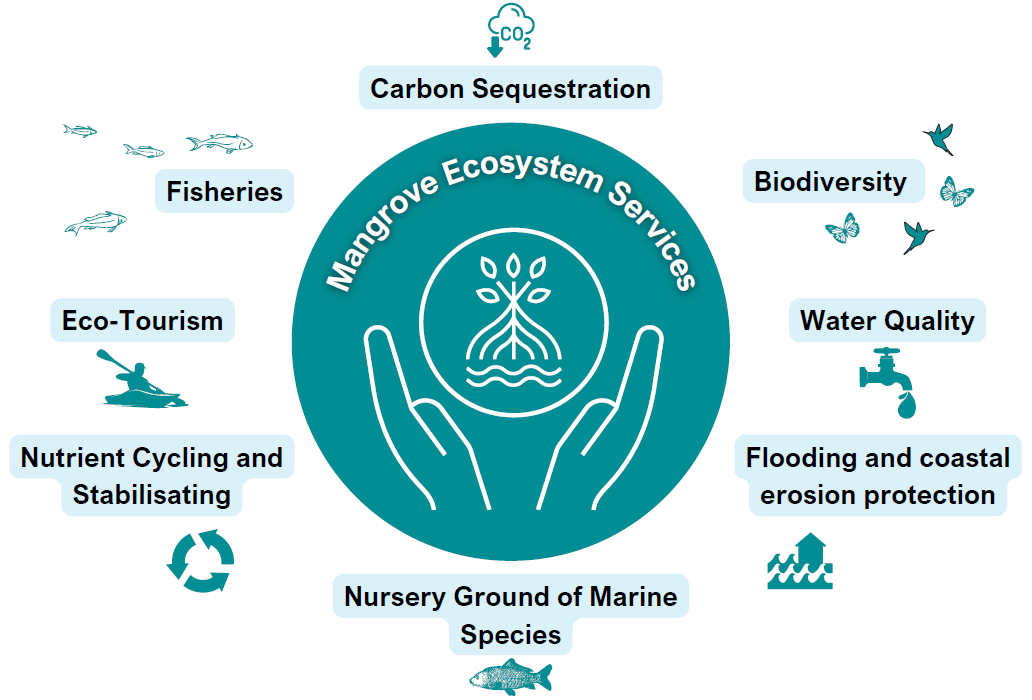30 January 2024 by Dr José António L. Barão-Nóbrega
Of all ecosystems on this planet, blue carbon ecosystems, including mangrove forests, tidal/salt marshes, and seagrass meadows are ranked second in the estimated dollar value of ecosystem services, with only coral reefs providing higher estimated values (Costanza et al. 2014; Heimhuber et al. 2023). This is because blue carbon ecosystems are highly productive and provide critical nursery habitats to a broad range of organisms. They also support many ecosystem services, including high rates of carbon sequestration, recreation, flood attenuation, reduced erosion, nutrient reduction, fisheries enhancement, and coastal protection (Mulder et al. 2020; Costanza et al. 2021; Macreadie et al. 2021). Here is a breakdown of what drives the high demand for mangrove restoration projects:
Biodiversity Conservation: Mangrove forests provide the habitat conditions to support a wide variety of marine and terrestrial species, including fish, crustaceans, birds, and mammals. The complex root systems of mangroves provide shelter and breeding grounds for many aquatic species, contributing to overall biodiversity.
Climate Change Mitigation: Mangroves ecosystems are important carbon sink mechanisms due to their ability to sequester significant amounts of carbon dioxide from the atmosphere and locking it in via incorporating it into their forest biomass and sediment. This has high climate change mitigation potential and thus protecting and restoring mangroves are crucial for the global effort to reduce GHG emissions.
Coastal Protection: Mangroves serve as natural barriers protecting coastal areas from erosion, storm surges, and extreme weather events. The dense root systems of mangroves stabilize terrestrial-marine threshold (i.e. the shoreline), helping to reduce the risk of damage to coastal communities and infrastructure, mitigating the impact of waves.
Community Resilience: Mangroves play a role in enhancing community resilience to climate change impacts. By acting as natural buffers against storms and sea-level rise, they reduce the vulnerability of coastal communities and provide a safety net during extreme events.
Fisheries Support: Mangrove ecosystems are often referred to as “nurseries of the sea” because they provide ideal breeding and nursery grounds for many commercially important marine species.
Economic Benefits: Mangroves contribute to the economic well-being of local communities through fisheries, tourism, and other ecosystem services.
International Recognition: International groups, such as the Intergovernmental Panel on Climate Change (IPCC), have recognized the climate mitigation value of these ecosystems and included them in the 2016 update to the 2003 Wetlands Supplement (IPCC, 2014). At an international level, it has been recognized that carbon sequestration and storage in the vegetation and soil of blue carbon ecosystems could be a key component of mitigation strategies in the face of climate change. Thus, actions that conserve, restore, and sustainability use coastal wetlands are needed to avoid emissions and maintain (and where possible enhance) coastal wetland sequestration and storage. These actions contribute to global and national carbon management and increase the resilience of the socioecological ecosystem (e.g. see Herrera-Silveira et al. 2020).

In summary, the high demand for mangrove projects largely stems from the plethora of benefits these ecosystems provide across the board that contribute to their high importance and key role they play worldwide. Mangrove restoration (and also protection) projects, when designed and implemented properly, are a powerful example of how nature-based solutions that can address some of the planet’s most pressing challenges.